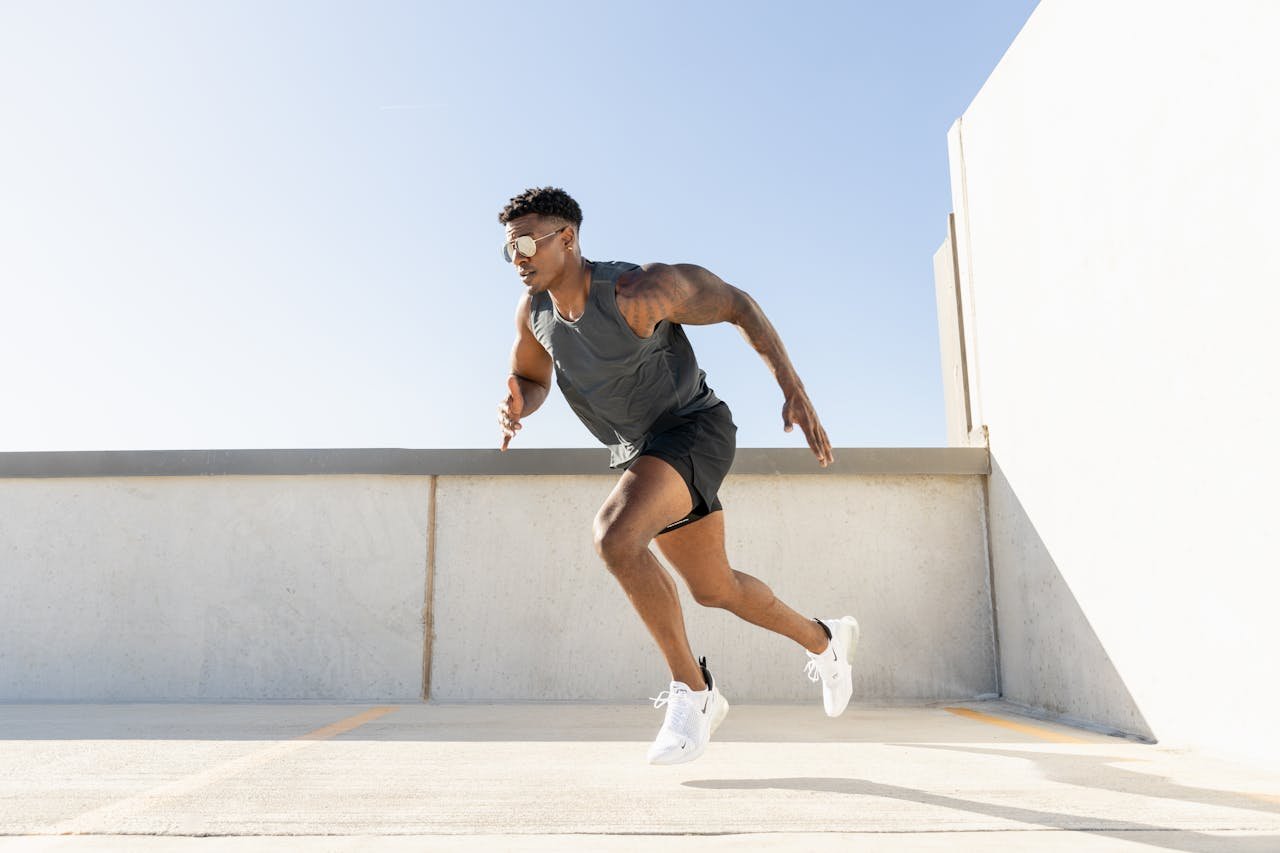Introduction to Tailored Workout Routines
In today’s fast-paced world, the importance of a well-planned workout routine cannot be overstated, particularly for men who may have recently experienced significant lifestyle changes. Factors such as remote work, sedentary habits, and altered daily routines can have a profound effect on physical health. Therefore, customizing workout routines based on individual fitness levels and goals is essential for males aiming to improve their overall well-being and fitness.
Understanding one’s body type and fitness goals is the foundation of an effective exercise regimen. Men may find that their physical requirements vary due to differences in age, metabolism, existing health conditions, and personal objectives, such as weight loss, muscle gain, or improved stamina. Tailored workout routines take these variables into consideration, ensuring that the exercises performed are appropriate for the individual’s fitness level, therefore, preventing injury and promoting gradual progress.
It is crucial to adopt a planned approach to fitness, as haphazard workouts can lead to frustration and burnout. By assessing one’s current condition, setting realistic goals, and developing a routine that aligns with these objectives, men are more likely to stay committed to their exercise plans. Moreover, a customized workout program can foster a sense of accomplishment, as individuals track their progress in a structured manner.
Ultimately, an individualized workout routine not only addresses the physical aspect of fitness but also contributes positively to mental health by enhancing motivation and discipline. For men who are ready to prioritize their health and fitness, tailoring a workout plan can be a transformative step toward achieving their desired fitness levels while accommodating their unique needs.
Understanding Fitness Levels: Beginner, Intermediate, and Advanced
Fitness levels can be categorized into three main groups: beginner, intermediate, and advanced. Each level carries distinct characteristics defined by an individual’s experience, capabilities, and training goals. Understanding where one fits in this spectrum is essential for selecting the appropriate workout routine.
Beginners are those who are new to physical training or have minimal experience with structured exercise. This group may include individuals who have recently decided to become more active for health reasons or those who have not participated in any fitness program. Typically, the primary goals for beginners include building a solid foundation, improving cardiovascular health, and developing fundamental strength. Workouts for beginners often feature low-impact exercises and shorter durations to prevent injury and encourage consistency.
Moving to the intermediate level, individuals in this category have acquired a certain degree of fitness, typically with six months to two years of consistent training. Intermediates are familiar with various exercises and have started to set specific goals, such as increasing muscle mass, enhancing athletic performance, or improving endurance. Their workouts become more diverse, integrating complex movements and higher intensity. Additionally, they may experiment with different training styles to overcome plateaus and keep their routines engaging.
Finally, advanced participants represent those who have extensive experience, often exceeding two years of dedicated training. Advanced athletes usually pursue specific objectives, such as competition preparation or maximizing fitness potential. They have a comprehensive understanding of their body’s capabilities and can implement advanced training techniques, including high-intensity interval training, periodization, and strength cycling. At this stage, workouts demand greater dedication and periodical assessments to optimize results.
By pinpointing one’s fitness level, individuals can tailor their workout routines effectively, ensuring they work towards achievable goals aligned with their current capabilities.
How to Define Your Fitness Goals
Establishing precise fitness goals is a pivotal step toward achieving success in any workout routine. It is imperative to begin by thoroughly assessing your current physical condition. This realistic self-evaluation includes understanding your weight, body composition, strength levels, and aerobic capacity. Additionally, consider your lifestyle and any health-related factors that could influence your fitness journey. For instance, are you a novice looking to lose weight, a moderate trainer aiming to build muscle, or an advanced athlete focusing on improving overall performance? Each category requires distinct approaches and objectives.
After evaluating your present state, you can begin the process of defining specific and measurable fitness goals. For weight loss, determine a target weight or a desired percentage of body fat. If building muscle is your priority, focus on specific lifts you wish to improve or a particular physique goal. Alternatively, if your aim is to enhance overall health, you may want to set goals related to exercise frequency, heart rate improvements during workouts, or increased flexibility.
It is essential to employ the SMART framework when setting your objectives—ensuring that your goals are Specific, Measurable, Achievable, Relevant, and Time-bound. For example, if your goal is to lose 10 pounds in three months, it is manageable and creates a timeline to remain on track. Furthermore, aligning your fitness goals with your personal interests can lead to increased motivation. Whether you enjoy weightlifting, running, or group classes, choose activities that engage you and align with your aspirations.
Having a clear purpose for your workouts not only enhances motivation but also allows for personal reflection and adjustment of your goals as you progress. Making the effort to define and meticulously outline your fitness objectives can significantly influence the overall outcome of your fitness journey.
Beginner Full Body Workout Routine
For individuals new to fitness, it is essential to establish a balanced workout routine to build strength, enhance endurance, and promote overall health. This beginner full-body workout routine is structured over three days, focusing on different muscle groups while ensuring a comprehensive approach to fitness.
Day 1: Upper Body
On the first day, focus on strengthening the upper body. Begin with 3 sets of 8-12 repetitions of push-ups, encouraging proper form by maintaining a straight body line from head to heels. Follow this with dumbbell shoulder presses, also 3 sets of 8-12 reps, to target shoulder muscles effectively. To complete the session, include bent-over dumbbell rows, which will engage the back muscles while promoting proper posture. Remember to rest for about 60-90 seconds between sets.
Day 2: Lower Body
Day two shifts focus to the lower body, vital for building strength and stability. Start with bodyweight squats; aim for 3 sets of 10-15 repetitions, ensuring that knees do not extend past the toes. Next, incorporate lunges—3 sets of 8-10 repetitions per leg—focusing on a controlled, steady movement. Finish with calf raises to strengthen the calves, completing 3 sets of 15-20 reps. Adequate recovery between sets is crucial; take 60-90 seconds for optimal performance.
Day 3: Core and Cardio
The final day emphasizes core stability and cardiovascular endurance. Begin with planks, holding for 20-30 seconds and repeating for 3 sets. Incorporate bicycle crunches for core strength, aiming for 3 sets of 10-15 repetitions. Round off the workout with 20 minutes of light cardio, such as brisk walking or cycling, to enhance cardiovascular fitness. Consistent hydration and proper post-workout nutrition are essential to support recovery and muscle growth.
Intermediate Workout Routine for Men
For men looking to take their fitness journey to the next level, an intermediate workout routine can effectively build muscle and enhance overall strength. The following 5-day split routine is designed to target specific muscle groups, ensuring an optimal balance between workout intensity and recovery. Each day focuses on a different area, allowing for comprehensive muscle engagement while emphasizing proper form and technique.
Day 1: Chest and Triceps
Begin with bench presses, aiming for 3 sets of 8-12 repetitions. Follow this with incline dumbbell presses and cable flys, each performing 3 sets. Triceps can be targeted through close-grip bench presses, dips, and triceps extensions, again aiming for 3 sets. Focus on increasing weight gradually to enhance muscle growth.
Day 2: Back and Biceps
The back workout should consist of wide-grip pull-ups or lat pull-downs for 3 sets, bent-over rows for 3 sets, and deadlifts for 3 sets, ensuring proper technique to avoid injuries. Incorporate bicep curls and hammer curls, also at 3 sets. Increasing volume on heavy lifting days can further promote muscle gain.
Day 3: Legs
Legs require special attention. Begin with squats, proceeding to leg presses and lunges, performing 3 sets for each exercise. Calf raises should also be included for balanced development. As an intermediate lifter, increasing the number of repetitions or weights will boost effectiveness.
Day 4: Shoulders and Abs
For shoulder day, utilize overhead presses and lateral raises for 3 sets, enhancing shoulder strength. Include plank variations and crunches for core stability, performing 3 sets for each. Increasing intensity through limiting rest periods can lead to increased endurance.
Day 5: HIIT and Active Recovery
This final day focuses on high-intensity interval training (HIIT). Consider circuits that involve various movements, like burpees, mountain climbers, and kettlebell swings. From each circuit, aim for 30 seconds of intense activity followed by 30 seconds of rest, repeating for 20-30 minutes. Active recovery methods such as yoga or light cardio can help improve flexibility and resilience.
Incorporating adequate rest days is essential, as they allow the muscles to recover and adapt to the increased workload. Listen to your body and adjust the intensity and volume based on personal capacity. With consistency and structured progression, this intermediate workout routine can significantly enhance physical performance and overall health.
Advanced Workout Routine for Experienced Lifters
For seasoned lifters looking to elevate their fitness routine, an advanced workout program can offer a new level of challenge. This regimen is designed to optimize muscle hypertrophy and strength gains through sophisticated techniques such as supersets and drop sets. Below, we discuss the components of an effective advanced workout routine.
The objective of this advanced routine is to push the body beyond its usual thresholds. Supersets involve executing two exercises back-to-back without rest, which not only amplifies muscle activation but also saves time. For example, pairing a bench press with bent-over rows targets opposing muscle groups simultaneously. This increases the intensity of the workout and encourages muscle growth by maximizing the time under tension.
Drop sets are another effective method for experienced lifters. In this technique, an individual performs an exercise at a high weight until failure, then immediately reduces the weight and continues with more repetitions. This approach intensifies muscle fatigue, compelling the muscles to adapt and grow. A practical application might include performing a set of squats at a heavy weight followed by a lighter set to failure, really driving home the point of muscle hypertrophy.
Additionally, incorporating compound lifts such as deadlifts, squats, and bench presses can further enhance strength and muscle gains. These exercises engage multiple muscle groups, allowing for greater overall conditioning. It is crucial, however, for seasoned lifters to focus on form to minimize the risk of injury.
To further maximize the effectiveness of this workout routine, experienced athletes are encouraged to integrate active recovery days, ensuring that muscle groups rest while still engaging in light movement. Nutrition also plays a key role; adequate protein intake supports muscle repair and growth. In conclusion, by embracing advanced techniques and maintaining focus on recovery, experienced lifters can significantly enhance their fitness achievements.
Adjusting Your Routine Based on Physiology
Every individual’s physiological makeup is unique, and understanding these differences is crucial when tailoring a workout routine. What may work effectively for one person might be unsuitable for another due to variations in body composition, metabolism, or recovery rates. To enhance the effectiveness of your fitness regimen, assess how your body responds to different exercises and adjust accordingly. Recognizing indicators such as increased heart rate, fatigue, or soreness can give insight into whether your routine is too taxing or properly aligned with your fitness level.
One essential aspect of modifying your workout routine is listening to your body’s signals. For example, if you consistently experience unusual pain or strain after performing specific exercises, it may be a sign to either reduce the intensity, modify the movements, or consult a fitness professional. Similarly, if you notice steady improvement in strength, endurance, or overall energy levels, this is a positive sign that your current routine may be appropriately challenging. Keeping a fitness journal can help track these responses and provide valuable insights into how to adjust your training program effectively.
Moreover, it is essential to understand the phases of workout recovery. After intense training sessions, your body requires time to repair muscle tissue and replenish energy stores. Neglecting recovery time can lead to overtraining, which is counterproductive and increases the risk of injury. Incorporating rest days and lighter workouts can aid in continued development and allow you to maintain a balanced physique. Evaluating how your body feels before, during, and after workouts forms the foundation for a sustainable and effective workout routine tailored to your unique physiology.
The Importance of Nutrition and Recovery
When it comes to achieving optimal fitness results, the synergy between nutrition and recovery cannot be overstated. Proper nutrition provides the essential fuel necessary for physical activity, while adequate recovery ensures the body repairs and strengthens itself after workouts. For anyone pursuing a structured workout routine, being mindful of dietary choices is of paramount importance.
A balanced diet should primarily consist of macronutrients including carbohydrates, proteins, and healthy fats. Carbohydrates serve as a primary energy source, fueling workouts and aiding in recovery. Protein is crucial for muscle repair and growth, making it vital for those engaging in strength training. Healthy fats support hormonal balance and overall health. Incorporating a variety of fruits and vegetables ensures that essential vitamins and minerals are adequately supplied, which play a significant role in energy production and recovery processes.
Additionally, hydration is a critical factor often overlooked. Proper fluid intake before, during, and after workouts aids in maintaining performance levels and optimizing recovery. Dehydration can lead to fatigue, decreased endurance, and impair muscle recovery, making it essential to drink water regularly throughout the day.
Recovery techniques are equally vital for supporting fitness goals. Incorporating stretching after workouts helps improve flexibility and reduces the risk of injury by loosening tight muscles. Furthermore, ensuring quality sleep is a non-negotiable aspect of recovery. Sleep plays a crucial role in muscle repair, cognitive function, and overall well-being. It is recommended that adults aim for seven to nine hours of sleep per night for optimal recovery.
Incorporating these aspects of nutrition and recovery into a workout routine will not only enhance performance but also promote long-term health and fitness sustainability. Prioritizing both elements can lead to a more efficient and effective fitness journey.
Creating Your Own Personalized Workout Plan
Developing a personalized workout plan is an essential step for any individual looking to improve fitness levels and achieve specific health goals. The customization of a workout routine should take into account various factors including current fitness level, individual preferences, and overall wellness objectives. To create an effective plan, begin by assessing your current fitness status. This initial evaluation allows you to identify strengths and areas needing improvement, facilitating a targeted approach.
Next, establish clear, measurable goals. Whether you’re aiming to build muscle, enhance endurance, or increase flexibility, defining these objectives will guide the structure of your routine. It is advisable to set SMART goals—Specific, Measurable, Achievable, Relevant, and Time-bound—which help in tracking progress effectively. Following goal setting, consider the components of fitness that you wish to work on, including cardiovascular health, strength training, and flexibility exercises. You may opt for a combination of various workout styles, such as high-intensity interval training (HIIT), circuit training, or traditional weightlifting, to add diversity.
Flexibility is paramount in a personalized workout plan. As you embark on your fitness journey, be prepared to experiment with different types of exercises and adjust your routine based on your personal experiences and outcomes. Regularly revisiting and modifying your plan ensures that it remains aligned with your evolving fitness levels and objectives. Additionally, consider incorporating rest days to facilitate recovery, as this plays a vital role in preventing injuries and promoting long-term sustainability.
Ultimately, the effectiveness of your workout plan hinges upon the ability to adapt and refine it according to your specific needs. By prioritizing customization, you empower yourself to develop a sustainable and enjoyable fitness routine that fosters lifelong health and well-being.
Conclusion: Start Your Fitness Journey Today
Embarking on a fitness journey can be a transformative experience for men at any stage of their lives. Through the tailored workout routines presented, it is evident that fitness is not a one-size-fits-all endeavor. Each individual has unique capabilities and requirements, necessitating a personalized approach to training. Whether you are a beginner, intermediate, or advanced athlete, adopting a routine that aligns with your fitness level can significantly enhance your results and overall well-being.
Understanding the fundamentals of weight training, cardiovascular exercises, and flexibility routines is crucial. Setting realistic and achievable goals will not only keep you motivated but will also allow you to track your progress effectively. The strategies outlined in the previous sections serve as a guide, emphasizing the importance of consistency and adaptability in working towards your fitness aspirations. As you refine your approach, consider how each component plays an integral role in achieving a well-rounded fitness profile.
Furthermore, patience and persistence are vital virtues on this journey. Results may not be immediate, but continuous effort combined with a positive mindset will yield significant changes over time. Community support, in the form of friends or professional trainers, can also enhance your accountability and motivation. It is essential to celebrate small victories along the way and remember that the pursuit of fitness is a lifetime commitment, rather than a short-term challenge.
Now is the perfect time to take charge of your health. By implementing the insights and recommendations discussed, you can start paving the way toward a healthier lifestyle. The journey ahead is not just about physical transformation but also about cultivating resilience and self-discipline. Take that first step today and embrace the rewarding experience of becoming a fitter, stronger version of yourself.

We publish content to inspire and motivate the new generation.
















